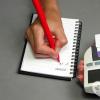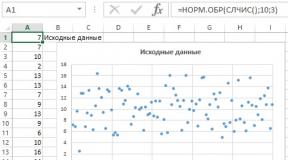Weight loss in type 2 diabetes
In this article you will learn:
Obesity, especially abdominal obesity, is a major trigger for the development of type 2 diabetes. Almost every such diagnosis is made against the background of overweight. Losing weight with type 2 diabetes is one of the most important tasks for a patient with this disease. And sometimes, when the patient acquires a normal body mass index, the “sweet” disease, as it is commonly called, goes into clinical remission for many years.
Why should you lose weight with type 2 diabetes?
To understand why weight loss is so important, you need to understand what generally happens in the body with obesity.
Excess fat stores reduce the sensitivity of tissues to insulin. Insulin resistance develops. And the 1st phase of insulin release in response to food intake is also disrupted, but the 2nd phase (bolus, delayed) is preserved.
As a result, after eating, blood sugar rises higher and higher, but cannot be utilized. In response, the pancreas releases large amounts of insulin into the blood (hyperinsulinism).
The level of glucose decreases (some is consumed by cells, some is debugged in fat depots), but there is still a lot of insulin in the blood. The person again begins to experience a feeling of hunger and there is another meal. A vicious circle is formed.
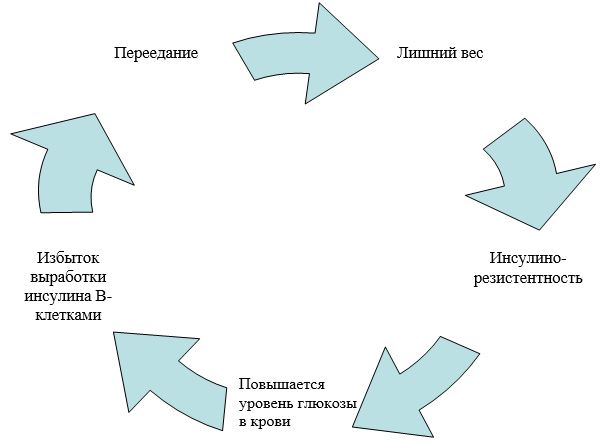
When weight is reduced, the amount of fat stores in the body decreases. This causes the cells to regain sensitivity to insulin. Then blood sugar returns to normal.
Pre-diabetes and early-stage diabetes are often treatable with weight loss alone and continued dieting.
But diabetes is detected, often after 3-5 years, when the function of pancreatic B-cells is impaired. Then, after all, you can’t do without tableted hypoglycemic drugs or sometimes insulin.
Only weight loss and adherence to a diet for life have a beneficial effect on the course of the disease, reduce the risk of developing complications of diabetes. They also help keep blood sugar more even without fluctuations and reduce the dose of hypoglycemic drugs.
What is the difference between the process of losing weight in diabetes from a healthy body?
It is just as important for a healthy obese person to lose weight as it is for a person with diabetes, as being overweight causes insulin resistance. And this, in turn, is a high risk of developing diabetes in the future, if you do not take measures to reduce weight.
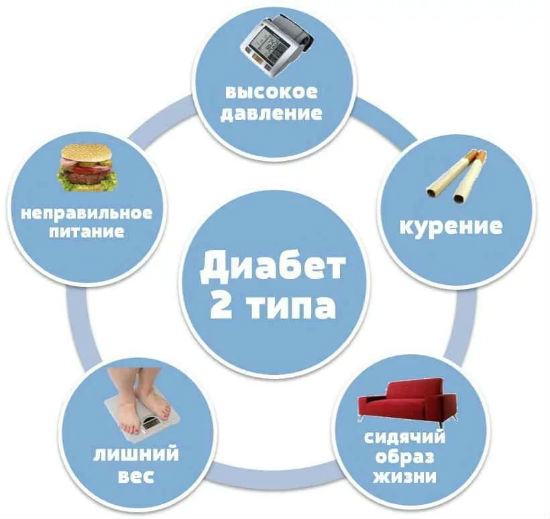 Causes of Type 2 Diabetes
Causes of Type 2 Diabetes Still, diabetes is a disease that leads to metabolic disorders. Therefore, there are some nuances in losing weight with a "sweet" disease.
1. Weight loss should be under medical supervision
This is because hypoglycemic drugs are often prescribed to help reduce weight and glucose levels. The main one is Metformin (Siofor, Glucophage, Metfogamma, etc.).
When carbohydrates are restricted, blood glucose levels decrease and dosage adjustments may be needed to rule out hypoglycemia.
2. You can't starve
In the process of weight loss, the patient is selected such a diet that he can observe constantly for life. And with starvation, 90% of cases end in breakdowns. This leads back to weight gain and hyperglycemia.
3. A low-carb diet is the diet of choice.
In diabetes, the metabolism of carbohydrates is disturbed. In order to eliminate the abrupt increase in blood sugar and reduce the load on the pancreas, the consumption of carbohydrates is maximally limited.
4. Parallel to the diet should be physical activity
Together with physical education, the process of losing weight goes much faster. With diabetes, physical activity should be regular and moderate. It is excluded to engage in the gym 1 time per week until exhaustion. This will negatively affect your body.

For starters, the simplest and most useful will be normal walking. Every day you need to walk 6 thousand steps at an average pace (about 1 hour of walking).
5. Vitamins are prescribed
It is especially important to take chromium. It has the ability to reduce sugar cravings while dieting. And it is important that chromium restores tissue sensitivity to insulin.
6. Remember to drink clean water
During the period of weight loss, more toxic substances are formed than usual. Drinking water is an excellent helper in removing waste products (toxins) from the body. Thanks to her, the state of health will remain good: weakness and headaches will not bother.
Often the media say that diabetes is a terrible disease, and it ends with disability at a young age. A person reacts incorrectly and perceives diabetes as a sentence.
But you need to explain to the patient that this is a myth and people with diabetes live long happy years. This will help patients accept the disease and change their lifestyle to avoid complications.
Diet for Type 2 Diabetes to Lose Weight
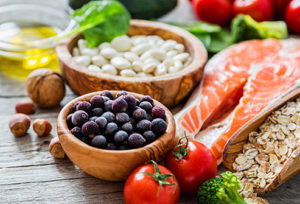 There is no time limit for a diabetic diet. It should become a lifestyle. There will always be food restrictions and you need to get used to it. Otherwise, violation of the rules leads to the development of complications.
There is no time limit for a diabetic diet. It should become a lifestyle. There will always be food restrictions and you need to get used to it. Otherwise, violation of the rules leads to the development of complications.
Goals of therapeutic nutrition:
- Reduce blood glucose and maintain its target level (preferably 3.3–6 mmol/l).
- Normalize insulin levels.
- Come to a normal body mass index (18.5–24.99), i.e., weight loss.
- Improve the course of severe complications, and eliminate the lungs.
- In pre-diabetes (impaired glucose tolerance), prevent the development of type 2 diabetes.
- At the initial stage of the disease, achieve stable clinical remission without taking drugs.
low carb diet
This diet fulfills all the goals. Its essence is a sharp restriction of carbohydrates by increasing the amount of healthy fats and the normal consumption of proteins.
Foods with a high and medium glycemic index are excluded from the diet and increased with a low one. Be sure to consume the right amount of water and fiber. As with any diet, at first the body rebuilds and resists. Initially, there may be a decrease in mood and a breakdown.
After 2 weeks, everything is getting better, and the patient feels great.
What is excluded from the diet
- Sugar, honey.
- Pastries, cakes, pastries, sweets and other sweets.
- fructose and sorbitol.
- Bread and other baked goods.
- All cereals (with the exception of steamed buckwheat, lentils, wild black rice).
- All types of flour (except nut flour).
- All types of pasta.
- Dry breakfasts, muesli.
- High-carbohydrate berries, fruits, dried fruits (you can use avocado, lemon, cranberries and, with good compensation, a handful of berries in season).
- From vegetables it is impossible potatoes, beets, corn.
- Bran (fiber separately can be).
- Juices (all types).
- Sweet carbonated drinks (Coca-Cola, Pepsi, Sprite and others).
- Beer and sweet alcoholic drinks.
- Glazed curds, sweet ready-made curds and yoghurts.
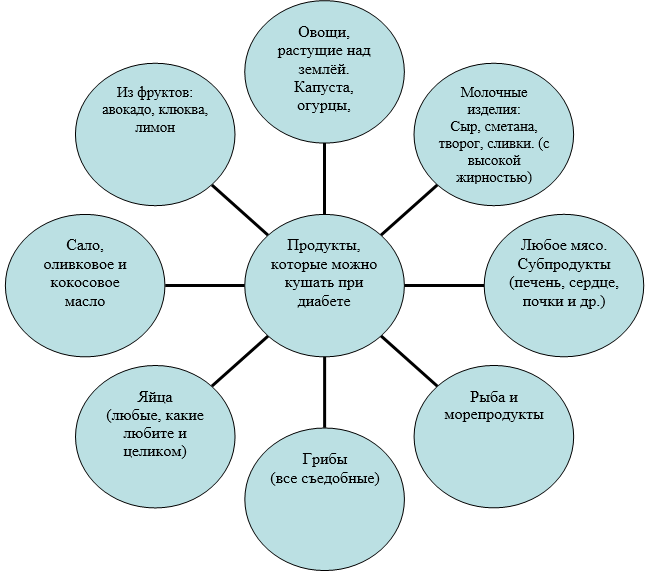 Foods to eat with diabetes
Foods to eat with diabetes This scheme presents foods that can be eaten without restriction, with any severity of diabetes, observing BJU.
With good compensation achieved, you can add a little to the diet for a change in small quantities:
- Vegetables growing underground (carrots, radishes, Jerusalem artichokes, etc.). It is desirable to consume them raw, because during heat treatment the glycemic index of these products increases.
- Up to 100 gr. per day of seasonal local fruits or berries (cherries, black currants, blueberries, strawberries, etc.).
- Up to 50 gr. per day nuts and seeds.
- 10 gr. dark chocolate per day (75% or more cocoa content).
- Once a week, a portion of porridge (30 grams of dry product). For example, steamed buckwheat, lentils, wild black rice. If after eating cereals after 2 hours, blood sugar is elevated, then you need to exclude them from the diet forever.
- Olives, olives.
- Nut flour (almond, sesame and others).
- Alcohol by occasion: strong or dry wine.
Using lists, everyone can make a suitable menu for themselves. This is all done individually, depending on preferences, degree of obesity, comorbidity.
Quantity and frequency of food intake, BJU
You can eat permitted foods until you feel full. There are no restrictions, but the measure should be in everything.
 It is not necessary to exceed the intake of protein above the norm, because this will badly affect the kidneys and intestines. In case of renal failure, the menu is agreed with the attending physician.
It is not necessary to exceed the intake of protein above the norm, because this will badly affect the kidneys and intestines. In case of renal failure, the menu is agreed with the attending physician.
The frequency of meals is different and depends on each patient individually. If a person is not hungry, then it is not necessary to eat 7 times a day. But this does not mean that the entire daily volume of food can be consumed in 2 times. After all, this increases the load on the pancreas.
3-4 meals are optimal. If it is more comfortable for a diabetic patient to eat more often, then this will by no means be a mistake.
The approximate ratio of BJU to lose weight in type 2 diabetes is 25/55/20.
The truth about diet foods
Currently, the so-called dietary products have become very popular. There are many fat-free products, fitness curds, yogurts, and bars in stores.
Only the population often does not realize that these are very harmful products.
For example, extracting fat from cottage cheese, it will not have such a consistency. To stabilize it, starch is added to the composition. This will already be a high-carbohydrate food, which is harmful in diabetes.
And all products with the name fitness mean that when they are used, a person will go in for physical activity. They contain a considerable amount of carbohydrates, which are needed by healthy people involved in sports. People believe that these products will help them lose weight and buy them in large quantities.
Do people with type 1 diabetes lose weight or gain weight?
Often patients with type 1 are not just thin, but even have a lack of body weight. At the onset of the disease, they can lose up to 10 kg of body weight.
This is due to the lack of insulin in the body. When there is no insulin, there is no synthesis of fats from carbohydrates and replenishment of the fat depot.
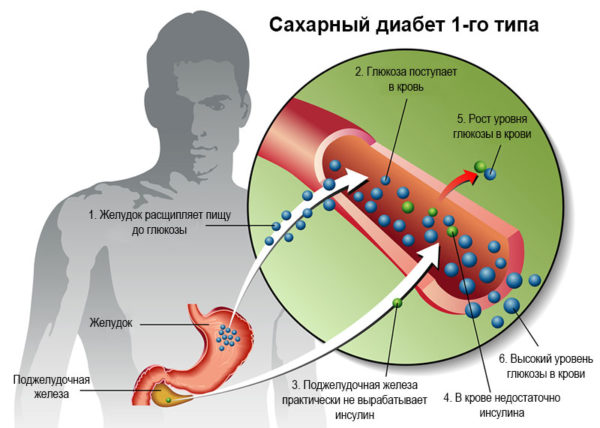
With type 1, in contrast to type 2 diabetes, the process of splitting proteins and body fat stores begins. As a result, the person loses weight.
After establishing the diagnosis and prescribing insulin injections, the patient needs to calculate the XE and the amount of carbohydrates in order to calculate the dose of insulin. In theory, a person with type 1 diabetes can eat everything, the main thing is to correctly calculate the dose of the drug. He shot insulin and ate what he wanted. Only this phenomenon is temporary and after eating pleasures in diabetes, health will begin to deteriorate. A constant increase in sugar will lead to complications.
Therefore, type 1 patients are also on a diet to lower their insulin dose and keep their blood glucose levels more even without fluctuations.
When do you get fat with type 1 diabetes?
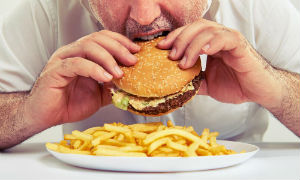
conclusions
The second type of diabetes has become an epidemic of the XXI century. The reason for this is the prevalence of obesity among the population. Excess weight leads to insulin resistance, which is a precursor to the development of type 2 diabetes.
With this disease, the metabolism and, first of all, the metabolism of carbohydrates suffer. That is why it is so important to lose weight with diabetes.
Weight loss and diet is often one of the main treatments. For this process to be most effective in diabetes, you need to follow a low-carb diet. And in order for weight loss to take place more actively, physical education classes are necessarily added.
These are the most important points in losing weight with type 2 diabetes. By changing your lifestyle and putting in hard work, you are doomed to success in the fight against excess weight and diabetes.




